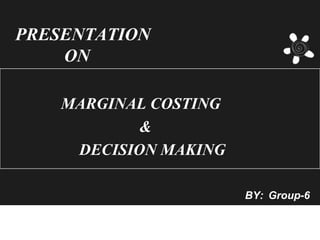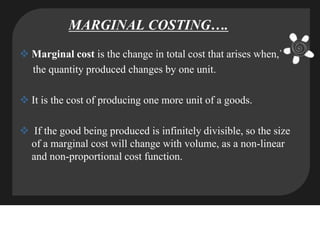Mrginal accounting
- 1. PRESENTATION ON MARGINAL COSTING & DECISION MAKING BY: Group-6
- 2. MARGINAL COSTINGŌĆ”. ’üČ Marginal cost is the change in total cost that arises when,` the quantity produced changes by one unit. ’üČ It is the cost of producing one more unit of a goods. ’üČ If the good being produced is infinitely divisible, so the size of a marginal cost will change with volume, as a non-linear and non-proportional cost function.
- 3. PRINCIPLES OF MARGINAL COSTINGŌĆ”. By selling an extra item of product or services following will happen: ’üČ Revenue will increase by the sales value of the item sold ’üČ Costs will increase by the variable cost per unit. ’üČ Profit will increase by the amount of contribution earned from the extra item. ’üČ Profit measurement should therefore be based on the analysis of total contribution.
- 4. ASSUMPTIONS OF MARGINAL COSTINGŌĆ”. The basic assumptions of marginal costing are : ’üČ Total variable cost is directly proportion to the level of activity. ’üČ However, variable cost per unit remains constant at all the levels of activities. ’üČ Per unit selling price remains constant at all levels of activities. ’üČ All the items produced by the organization are sold off.
- 5. Features of Marginal costing: ’üČ It is a method of recording costs and reporting profits. ’üČ It involves ascertaining marginal costs which is the difference of fixed cost and variable cost. ’üČ Fixed costs are treated as period charge and are written off to the profit and loss account in the period incurred. ’üČ Only variable costs are taken into consideration while computing the product cost..
- 6. ’üČ Contribution ( Per unit) = Sale per unit - Variable Cost per unit ’üČ Total profit or loss = Total Contribution - Total Fixed Costs or Contribution = Fixed Cost + Profit or Profit = Contribution - Fixed Cost ’üČ Profit Volume Ratio = Contribution/ Sale X 100 ’üČ Break Even Point is a point where Total sale = Total Cost
- 7. MARGINAL COSTING APPROACHŌĆ”. Charged cost of goods produced Charged as DIRECT (RM,L) expense when VARIABLE goods are sold (F.OH)
- 8. MARGINAL COSTING APPROACHŌĆ”. Fixed( F.OH) Charged as & all selling expenses and adm. when overhead incurred
- 9. ADVANTAGES OF MARGINAL COSTINGŌĆ”. ’üČ Helps in managerial decisions. ’üČ Cost Control. ’üČ Simple Technique. ’üČ Constant cost per unit. ’üČ Realistic valuation of stocks. ’üČ Aid to profit planning.
- 10. DISADVANTAGES OF MARGINAL COSTINGŌĆ”. ’üČ Ignores time factor. ’üČ Less effective in capital intensive industries. ’üČ Difficulty in Application.
- 11. DECISION MAKINGŌĆ”. ’üČ It involves selecting the best course of action from two or more available alternatives. ’üČ And, the decision is to be taken will be, affected by cost & other factors.
- 12. Special Decision Making AreasŌĆ”. ’üČ Selling price decisions. ’üČ Make or Buy decisions. ’üČ Sales mix decisions. ’üČ Selection of a suitable method of production. ’üČ Plant shut down decisions.
- 13. DIFFRENTIAL COST ANALYSISŌĆ”. ’üČ ItŌĆÖs a special technique to help management in decision-making which shows how costs and revenues would be different under different alternative course of action. ’üČ Its a difference in cost between one alternative and another.
- 14. LETŌĆÖS HAVE SOME PRACTICAL EXPERIENCEŌĆ”














